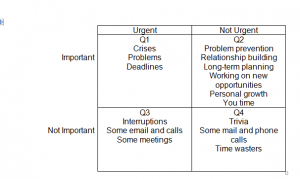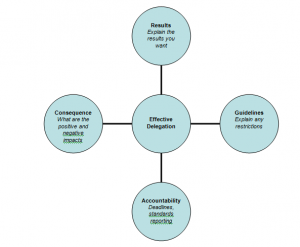Get the Habit – Habit 3 – First Things First – Managing Priorities
In my first blog on Stephen Covey’s Seven Habits of Highly Effective People, Habit 1 taught us that being proactive is an essential underpinning to being more effective; in Habit 2 we explored what we really want to be and do in our lives. Habit 3 is about the way in which we go about doing this – the discipline of carrying things out and prioritising.
The term ‘time management’ is regularly used in business. In The Seven Habits of Highly Effective People, Stephen Covey points out that to some extent this term is misleading – “The challenge is not to manage time but to manage ourselves.” – ie the problem is not with time itself but how we use it. Covey proposes that we increase our effective use of time through consideration of the relative worth of activities in the context of our life purpose.
The typical activities that we get involved in can be mapped into a 2×2 matrix using the dimensions of urgency (the extent to which things demand our immediate attention) and importance (the extent to which the task will deliver results that contribute to our mission and priorities).
The result is four quadrants. Many of us will find that we spend the majority of our time dealing with things in the two quadrants in the ‘urgent’ column…and the more we focus on activities in these quadrants, the more time we will have to spend there – it’s the catch 22 of perpetual firefighting and being driven by others; a short-term focus where we react to urgent demands and end up out of control.
The key quadrant to spend time in is II – making ourselves to do this is at the heart of effective personal management. People who focus their efforts in this quadrant are opportunity minded, feeding possibilities and starving problems by anticipating them and planning to prevent crises from happening; focusing on things that will move them towards what they want to achieve. By this forward thinking, the ‘urgency’ dominance of quadrant I is diminished.
Sounds good? I can see some of you contending that this is all well and good if you have the TIME to do it. We have to change that paradigm to one where first and foremost we plan the time to do the most important things, gaining time from Quadrants III and IV by saying no to people and putting aside trivial tasks that are not contributing to our results or by delegating.
Effective delegation is your friend in increasing the time you spend in Quadrant II. The error that some people make is to adopt a style of delegation that Stephen Covey calls ‘gofer’ delegation – go do this, go do that – effectively barking instructions and having someone run round doing small tasks. In reality this gains little time because it encourages reliance on the ‘delegator’ to give the next instruction, increasing interruptions. The style of the delegating that we need to adopt is ‘stewardship’ where your delegation focuses on the results you want and allows the other person to use their initiative, choose their method and bring their ideas to the task. They take responsibility for the outcome. This is illustrated in the figure below.
The message is that the hour spent explaining a job thoroughly to someone else and truly delegating ‘stewardship’ can more than gain you back that time to spend on the things that really matter to your purpose and mission – particularly if it is a regular task/activity.
Finally in ‘getting this habit’, Covey proposes a way of approaching the identification and scheduling of activities which brings Quadrant II activities to the top of mind.
- Identify all the roles you play in your life (personal and business), breaking them down as much as possible – eg husband/wife, mother/father, treasurer of PTA, manager of team, chair of health and safety staff group, customer service supervisor, etc…NB you only need to make this list once and it can then be your reference for each week’s planning.
- For each role, identify your goals for the week, the things that you want to achieve that contribute to your longer term objectives and mission. If necessary break these goals down into smaller chunks – the tasks that make them up.
- Now take a weekly diary – preferably one with timeslots – and remember you have the evenings and weekends to schedule too for your personal goals.
- For each of the week’s goals/tasks that you have identified, schedule in a timeslot.It’s important that you view these scheduled activities as appointments, even if they don’t involve other people. If you do this, as the week progresses, the Quadrant I, III and IV activities will have to fit around the times you’ve committed to for your most important goal focused priorities. Be amazed at the difference this makes to the way you manage your life.Of course, you will need to retain the need to be flexible in some circumstances and to be able to seize on opportunities that crop up. What matters is that you are making a conscious decision to do this.
Here are three tasks to put this habit into practise:
1. For a day map the things that you do and the time they take you into the importance/urgency matrix. Where are you spending most of your time?
2. What one thing could you do (which you aren’t doing now) that if you did on a regular basis would make a big difference to your personal life? Now answer the same question for your business life. This might be a delegation activity. Decide when you are going to start doing do this and schedule it in.
3. Have a go at identifying and scheduling next week’s activities using Stephen Covey’s approach.
series of articles based on Stephen Covey’s acclaimed book “The 7 Habits of Highly Effective People” – to view the other articles click the links below:
Habit 2 – Begin with the End in Mind (goals and vision)
Habit 5 – Seek First to Understand (listening skills)
Habit 6 – Synergise (know your strengths and those of others)
Habit 7 – Sharpen the Saw (look after your wellbeing)
The 7 Habits of Highly Effective People – Powerful Lessons in Personal Change by Stephen Covey (1989)is published by Franklin Covey Co ISBN 0-684-85839-8

